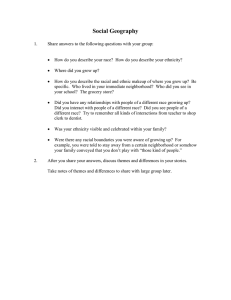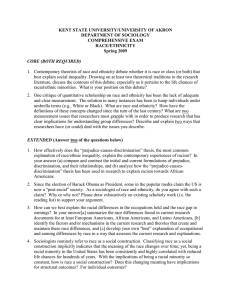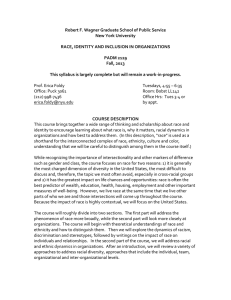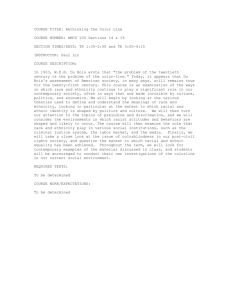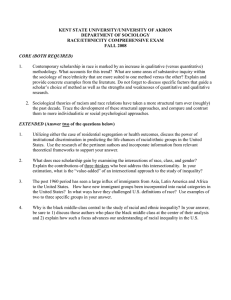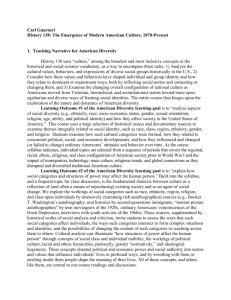Robert F. Wagner Graduate School of Public Service New York University
advertisement
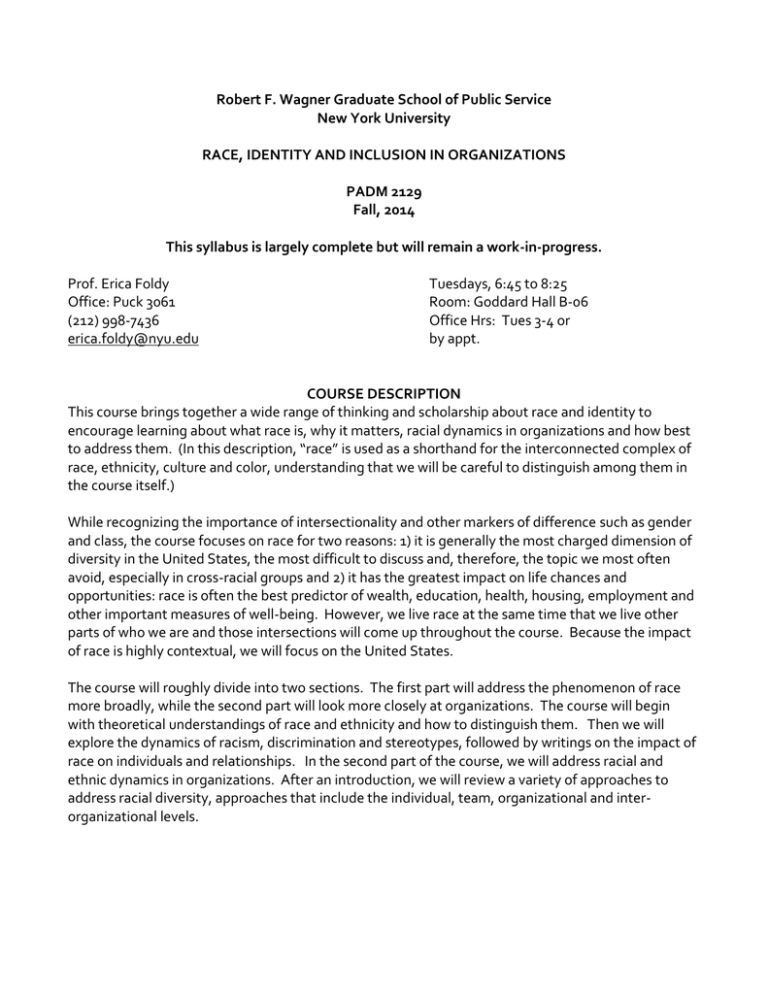
Robert F. Wagner Graduate School of Public Service New York University RACE, IDENTITY AND INCLUSION IN ORGANIZATIONS PADM 2129 Fall, 2014 This syllabus is largely complete but will remain a work-in-progress. Prof. Erica Foldy Office: Puck 3061 (212) 998-7436 erica.foldy@nyu.edu Tuesdays, 6:45 to 8:25 Room: Goddard Hall B-06 Office Hrs: Tues 3-4 or by appt. COURSE DESCRIPTION This course brings together a wide range of thinking and scholarship about race and identity to encourage learning about what race is, why it matters, racial dynamics in organizations and how best to address them. (In this description, “race” is used as a shorthand for the interconnected complex of race, ethnicity, culture and color, understanding that we will be careful to distinguish among them in the course itself.) While recognizing the importance of intersectionality and other markers of difference such as gender and class, the course focuses on race for two reasons: 1) it is generally the most charged dimension of diversity in the United States, the most difficult to discuss and, therefore, the topic we most often avoid, especially in cross-racial groups and 2) it has the greatest impact on life chances and opportunities: race is often the best predictor of wealth, education, health, housing, employment and other important measures of well-being. However, we live race at the same time that we live other parts of who we are and those intersections will come up throughout the course. Because the impact of race is highly contextual, we will focus on the United States. The course will roughly divide into two sections. The first part will address the phenomenon of race more broadly, while the second part will look more closely at organizations. The course will begin with theoretical understandings of race and ethnicity and how to distinguish them. Then we will explore the dynamics of racism, discrimination and stereotypes, followed by writings on the impact of race on individuals and relationships. In the second part of the course, we will address racial and ethnic dynamics in organizations. After an introduction, we will review a variety of approaches to address racial diversity, approaches that include the individual, team, organizational and interorganizational levels. COURSE EXPECTATIONS This course assumes that we all have something to contribute to this conversation and that we all have something to learn. That means people of all races and ethnicities have perspectives that grow out of those backgrounds and if some people choose not to participate, the conversation and our learning will be poorer for it. So, I ask for three agreements: one, that you bring a willingness to search deeply and introspectively about your own assumptions and behaviors, including identifying those areas in which you need to learn; two, that you will help others learn by voicing your thoughts and reactions, understanding that they are partial and limited; and three, that you bring curiosity and an eagerness to inquire into how others make sense of the world. COURSE TEXTS Each class will feature a variety of readings from a wide range of sources, both scholarly and practitioner. Most readings are posted on NYU Classes but a number are in the course packet, available at Unique Copy Center. One book is required: Schein, E. H. 2013. Humble Inquiry. Berrett-Koehler Publishers. It is available at the NYU bookstore or on-line from Amazon or other retailers where it may be cheaper. Check NYU Classes every week for announcements, reminders, readings, assignments, etc. COURSE REQUIREMENTS There are five course requirements; each accounts for a percentage of your grade. Here is an overview: “Where I’m From”-- 5 pages Journal – no page length Case Analysis – 4 pages Final Paper -- 10 pages Class participation Total 15% 20% 15% 30% 20% -------100% All papers should be double-spaced, have 1 inch margins and use 12 pt. font. Papers should be posted on NYU Classes one hour before class begins on the day they are due; if not, they will be considered one day late. (Instructions for posting will be provided.) Late assignments will lose one letter grade for each day they are late (which begins immediately after the posting deadline). If you are facing some kind of serious and urgent situation that could delay turning in the assignment, contact me as soon as possible to discuss other arrangements. 1) “Where I’m From” – due September 23 (5 pages): In this assignment, you will write a kind of racial-cultural autobiography, addressing the question “How did I come to be who I am?” Think about the influence of race and ethnicity in particular but feel free to consider other influences, like gender, class, religion, and sexual orientation. You may also want to explore how race and ethnicity have interacted with other aspects of your identity. Consider these questions: How have these elements shaped your life experience? To what extent have you experienced privilege and marginalization (or both) based upon them? How have your various facets influenced your interest in public service and your thoughts about your career? Reference at least one reading. (This assignment adapted from a syllabus by Jody Cohen.) 2) Journal – due October 7 and December 9 (no page requirement): Keep a written journal in which you record your thoughts, comments and reflections triggered by and in response to the assigned course readings, as well as the class exercises and interactions. Feel free to weave in other reading you are doing, current events, or other observations about the dynamics of race, identity and inclusion as they apply to course themes. At a minimum, you should write one entry per week. I will review this twice, once around week 7 and once at the end. Evaluations of this assignment will be based on (1) completeness (at least one entry for each week of the course), (2) evidence of having actually read the assigned material, and (3) engagement with the topics. (Assignment adapted from Stacy Blake-Beard [2000]: syllabus for Cultural Diversity in the Workplace.) 3) Case analysis – due December 2 (4 pages): In this assignment, you will analyze the case “Casa de Esperanza” using concepts from the course and the readings. 4) Final paper – due December 16 (10 pages). In this assignment, you will design some kind of training or workshop (or a set of such events) on a topic related to race, identity and inclusion in organizations. The training must be designed for a very particular audience (eg, employees of social service agencies, or environmental funders, or school principals). Therefore, you have to both think about the content (related to race/ethnicity) of what you want to impart as well as how to make that content relevant to a particular context. 5) Class participation: The class will rely almost entirely on group discussion so your preparation and participation in class is critical to its success. In addition to your thoughtful contribution to class discussion (more detail below), your grade will also be based on bringing a Learning Resource to the attention of the full class. This means finding some kind of video, report, blog posting, photo, website, book or some other kind of resource that relates to the class topics. You will have about five minutes to describe the resource and connect it to course themes. You will sign up for a week to present. “A” Level Participation Absent no more than once during the semester. Sends email ahead of time to tell me you will miss class. Regularly participates in class discussion. Comments are clear, succinct, and relevant to the current conversation. Takes risks in answering difficult questions or offering unpopular ideas. Is prepared for class, as evidenced by: o Applying ideas from the readings to the discussion o Challenging or extending ideas in the readings o Integrating or contrasting ideas from current readings with previous readings “B” Level Participation Absent no more than twice. May not send email to me ahead of time. Participates occasionally. Comments are sometimes unclear, long-winded or not relevant to discussion. Answers questions but rarely takes risks. Is less prepared for class (see above) “C” Level Participation Absent no more than three times. Doesn’t email professor ahead of time. Participates rarely.. Is unprepared for class. Sept 2 Sept 9 Sept 16 Sept 23 Sept 30 Oct 7 Oct 14 Oct.21 Oct 28 Nov 4 Nov 11 Nov 18 Nov 25 Dec 2 Dec 9 COURSE OVERVIEW Introduction to the course and each other Race, ethnicity, culture and color Racism, discrimination and stereotypes Impact of race and ethnicity on individuals Impact of race and ethnicity on relationships Racial and ethnic dynamics and discrimination in organizations NO CLASS The legal context Making change at the individual level Making change at the interactional level 1 Making change at the interactional level 2 Making change at the team level Making change at the organizational level 1 Making change at the organizational level 2 Course wrap up COURSE READINGS AND ASSIGNMENTS September 2: Introduction to the class and each other To prepare for first class session (readings posted at NYU Classes) 1) Bernard, E. 2006. Teaching the N-Word. The American Scholar 74. 4 (Autumn 2005): 46-59. 2) Foldy, E. G. 2005. Claiming a Voice on Race. Action Research 3 (1): 33-54. 3) Hicok, B. 2008. A Primer. New Yorker, May 19. September 9: Race, ethnicity, color and culture 1) Singleton, G and Linton, C. 2006. Courageous Conversations about Race, pp. 167-173. 2) Kay Deaux. 2006. To Be an Immigrant. Russell Sage Press. Chapter Five: Who am I? The construction of ethnic identity. 3) Gallegos, PI and Ferdman, BM 2012. Latina and Larino ethnoracial identity orientations: A dynamic and developmental perspective. In CL Wijeyesinghe & BW Jackson III (eds.) New Perspectives on Racial Identity Development: A Theoretical and Practical Anthology. New York University Press. 4) Krogstad, J. M. & Cohn, D. 2014. US census looking at big changes in how it asks about race and ethnicity. Pew Research Center. March 14. 5) NPR Radio Lab. Listen to “Race doesn’t exist. Or does it?” http://www.radiolab.org/story/91654-race-doesnt-exist-or-does-it/ Other reading: 1) M. Omi and H Winant. 1994. Racial Formation in the United States. 2nd edition. Routledge. 2) West, C., & Fenstermaker, S. (1995). Doing difference. Gender & Society, 9, 8-37. 3) Tatum, B. D. Why are all the black kids sitting together in the cafeteria? Basic Books 1997. Second ed. 4) Helms, J. E. (1990). Toward a model of white racial identity development. In J. E. Helms (Ed.), Black and White Racial Identity: Theory, Research and Practice (pp. 49-66). New York: Greenwood Press. 5) Nell Irvin Painter. 2010. The History of White People. WW Norton. Selected chapters. 6) Omi, M. 2010. “Slippin’ into darkness”: The (re)biologization of race. Journal of Asian American Studies 13 (3). 7) Perry, JC, Vance, KS & Helms, JE. 2009. Using the people of color racial identity attitude scale among Asian Americans college students. American Journal of Orthopsychiatry 79 (2): 252-260. September 16: Racism, discrimination and stereotypes 1) Coates, T. 2014. The case for reparations. The Atlantic. May 21. 2) Microaggressions Project website http://www.microaggressions.com/ 3) Wang et al. 2011. When the seemingly innocuous “stings”: Racial microaggressions and their emotional consequences. Personality and Social Psychology Bulletin 37. 4) Dovidio, J. F. and Gaertner, S. L. 2005. Color blind or just plain blind? The pernicious nature of contemporary racism. Nonprofit Quarterly, Winter. 5) Joshua Aronson. 2004. The threat of stereotype. Educational Leadership 62 (3) pp 14-19. Other reading: 1) Claude Steele. 2010. Whistling Vivaldi. WW Norton. (Practitioner-friendly book about stereotype threat.) 2) Fiske et al. 2002. A model of (often mixed) stereotype content: Competence and warmth respectively follow from perceived status and competition. Journal of Personality and Social Psychology. 32 (6). 3) Pew Research Center.2012. The Rise of Asian Americans. 4) Hing, J. 2012. Asian Americans respond to Pew: We’re not your model minority. Color Lines. June 21. 5) Alexander, M. 2010. The New Jim Crow: Mass Incarceration in the Age of Color Blindness. New Press. September 23: The impact of racial and ethnic identity on individuals 1) NR Todd and EM Abrams. 2011. White dialectics: A new framework for theory, research and practice with white students. The Counseling Psychologist 39. 2) KP White. 2002. Surviving hating and being hated: Some personal thoughts about racism from a psychoanalytic perspective. Contemporary Psychoanalysis 38 (3). 3) Ung, Tien. Beyond translation. Undated manuscript. ASSIGNMENT DUE: Where I’m From (cultural autobiography) Other reading: 1) Alexie, S. 1993. Indian Education (from The Lone Ranger and Tonto Fistfight in Heaven). Atlantic Monthly Press. 2) Holvino, E. 2010. Doing OD from the margins: Taking on the complexity of identities in organizations. OD Practitioner 42 (2): 54-58 [The writer is Puerto Rican and writes about the experiences of Latino/as. OD is Organization Development.] 3) Roose, K. 2012. Muslims on Wall Street, bridging two traditions. New York Times. April 14. 4) Berg, David S. 2002. Bringing one’s self to work: A Jew reflects. Journal of Applied Behavioral Science 38 (397). 5) Tim Wise. 2011. White Like Me. Soft Skull Press. 6) Frankenberg, R. 1993. White Women Race Matters: The Social Construction of Whiteness. University of Minnesota Press. Introduction: points of origin, points of departure; Chapter 6 Thinking through race 7) Ella LJE Bell and SM Nkomo. 2001. Our separate ways: Black and white women and the struggle for professional identity. Harvard Business School Press. 8) Bumbaugh, S. 2012. Barack Obama: Next in a long line of bi-cultural black leaders. Washington Post. December 7. September 30: The impact of racial and ethnic identity on relationships 1) Parker, Pat. For the white person who wants to be my friend. 2) Foldy, EG and Buckley, TR. 2014. The Color Bind: Talking (and not Talking) about Race at Work. Chapters 1, 7 and 8. The Russell Sage Foundation. 3) Tatum, B. D. & Ayvazian, A. 1994. Women, race and racism: A dialogue in black and white. Wellesley Centers for Women. 1-10. Note: We will have a guest speaker: Prof. Tamara Buckley from Hunter College and the Graduate Center at City University of New York Other reading: 1) Macrae, M. and Short, E. 2010. Racial and cultural dynamics in group and organizational life: Crossing Boundaries. Sage Publications. 2) Thomas, D. A. 1989. Mentoring and irrationality: The role of racial taboos. Human Resource Management 28 (2): 279-290. 3) JN Shelton. 2003. Interpersonal concerns in social encounters between majority and minority group members. Group Processes and Intergroup Relations 6. 4) Richeson, J. A. & Shelton, J. N. 2007. Negotiating interracial interactions: Costs, consequences and possibilities. Current Directions in Psychological Science 16 (6): 316-320. 5) Robert Putnam. 2007. E Pluribus Unum: Diversity and community in the twenty-first century. Scandinavian Political Studies vol 13, no 2, 137-174. 6) Jonas, M. 2007. The downside of diversity. Boston Globe, August 5. October 7: Racial and ethnic dynamics and discrimination in organizations 1) Ely, RJ and Thomas, DA. 2001. Cultural diversity at work: The effects of diversity perspectives on work group processes and outcomes. Administrative Science Quarterly 46 (2). 2) Skrentny, J. D. 2014. Only minorities need apply. New York Times, May 6. 3) Brief et al. 2000. Just doing business: Modern racism and obedience to authority as explanations for employment discrimination. Organizational Behavior and Human Decision Processes. 81 (1). 4) Yoshino, K. & Smith, C. 2013. Uncovering talent: A new model of inclusion. Deloitte University. Note: We will have a guest speaker: Merle McGee, Chief Program Officer at the YWCA of NYC. ASSIGNMENT DUE: JOURNAL Other reading: 1) RM Kanter. 1977/1993. Men and Women of the Corporation. Basic Books. chapter 8: Numbers: Minorities and Majorities, pp. 206-245. 2) Brief, A.P. et al. 2005. Community matters: Realistic group conflict theory and the impact of diversity. Academy of Management Journal 48 (5): 830-844. 3) JN Baron and J Pfeffer. 1994. The social psychology of organizations and inequality. Social Psychology Quarterly 58 (3). 4) VC Plaut. 2004. Cultural models of diversity in America: The psychology of difference and inclusion. In Engaging Cultural Differences, ed by R Schweder, M. Minow, H R Markus. Russell Sage. 365-395. 5) Ospina and Foldy. 2009. A critical review of race and ethnicity in the leadership literature: Surfacing context, power and the collective dimensions of leadership. Leadership Quarterly 20. 6) DA Thomas and JJ Gabarro. 1999. Breaking through: The making of minority executives in corporate America. Harvard Business School Press. 7) G. Hofstede. 1992. Culture and organizations: software of the mind: McGraw Hill. 8) Cuddy, A J C, Glick, P., & Beninger, A. 2011. The dynamics of warmth and competence judgments, and their outcomes in organizations. Research in organizational Behavior 31: 73-98. 9) Roberson et al. 2008. When group identities matter: Bias in performance appraisal. Academy of Management Annals, vol 1. 10) Castillo, E J. 2008. Gender, race and meritocracy in organizational careers. American Journal of Sociology. 11) Lai, L. and Babcock, L. C. 2013. Asian Americans and workplace discrimination: The interplay between sex of evaluators and the perception of social skills. Journal of Organizational Behavior 34: 310-326. October 14: NO CLASS October 21: The Legal Context 1) Gomez-Mejia, L. R., Balkin, D. B., and Cardy, R. L. 2010. Chapter 3, “Understanding equal opportunity and the legal environment,” pp. 87-122. Managing Human Resources, 6th ed. Prentice-Hall. 2) Heilman, M. E. 1996. Affirmative action’s contradictory consequences. Journal of Social Issues 52 (4): 105-109. 3) Kenji Yoshino. 2006. Covering: The hidden assault on our civil rights. Random House. Brief excerpt pp. 17-19; chapter 6: Racial Covering.pp. 111-141. 4) Hing, J. 2012. How diversity trumped equity – and may kill affirmative action. Color Lines. October 10. 5) The Opportunity Agenda. 2012. Expanding opportunity: Messaging guidance for talking about Fisher v University of Texas. October 3. October 28: Making change at the individual level 1) ND Hansen et al. 2000. Multicultural competence: Criteria and case examples. Professional Psychology: Research and Practice 31 (6). 2) Tervalon, M and Murray-Garcia, J. 1998. Cultural humility versus cultural competence: A critical distinction in defining physician training outcomes in multicultural education. Journal of Health Care for the Poor and Underserved 9 (2). 3) European-American Collaborative Challenging Whiteness. 2005. When first-person inquiry is not enough: Challenging whiteness through first and second-person inquiry. Action Research 3: 245. Other reading: 1) Krauss, B. J., Goldsamt, L., Bula, E. & Sember, R. 1997. The white researcher in the multicultural community: Lessons in HIV prevention education learned in the field. Journal of Health Education 28 (6). 2) Day-Vines, N.L. et al. 2007. Broaching the subjects of race, ethnicity and culture during the counseling process. Journal of Counseling and Development 85 (4): 401-409. November 4: Making change at the interactional level 1 Schein, E. H. 2013. Humble Inquiry. Berrett-Koehler Publishers. Taylor, S. S. Forthcoming. You’re a Genius: Using Reflective Practice to Master the Craft of Leadership. Chapter 3. 3) Antal, A. B. & Friedman, V. J. 2008. Learning to negotiate reality: A strategy for teaching intercultural competencies. Journal of Management Education 32 (3): 363-386. (I will provide specific pages to focus on.) Note: Prepare a two-column case. These are due Saturday, November 1 by noon. 1) 2) November 11 Making change at the interactional level 2 1) Arieli, D, Friedman VJ and Agbaria, K. 2009. The paradox of participation in action research. Action Research 7 (3): 263-290. November 18 Making change at the team level 1) DiStefano, J. & Maznevski, M. 2000. Creating value with diverse teams in global management. Organizational Dynamics 29 (1): 45 – 63. 2) Holvino, E. and Sheridan, B. 2003. Working across differences: Diversity practices for social change. Center for Gender in Organizations, Briefing Note 17. April. 3) Foldy, EG and Buckley, TR. 2014. The Color Bind: Talking (and not Talking) about Race at Work. Russell Sage. Chapter 4 “Color cognizant practice: Team North.” November 25 Making change at the organizational level 1 1) Cox, T., Jr. 1991. The multicultural organization. Academy of Management Executive 5 (2): 3447. 2) Merrill-Sands, D, Holvino, E with Cumming, J. 2000. Working with Diversity: A focus on global organizations. Center for Gender in Organizations Working Paper, pp. 58-67. Note: We will have a guest speaker: Hedieh Fakhriyazdi, Global Diversity & Social Responsibility Manager at Weil Gotshal and Manges, LLP. December 2 Making change at the organizational level 2 1) Ramos, M. C. & Chesler, M.A. 2010. Reflections on a cross-cultural partnership in multicultural organizational development efforts 2) Bailyn, L. and Fletcher, J. K. 2003. The equity imperative: Reaching effectiveness through the dual agenda. Center for Gender in Organizations, Briefing Note 18. July. 3) Crossroads Anti-Racism Organizing and Training. 2007. Teaching and training methodology documentation and evaluation report. Focus on pp. 14-23 (Parts A and B.) Accessed 6/12/14. http://crossroadsantiracism.org/wp-content/themes/crossroads/PDFs/Crossroads_AntiRacism_Documentation_w-_Appendices.pdf 4) CompassPoint Nonprofit Services. n.d. Multicultural organizational development in nonprofit organizations: Lessons from the Cultural Competence Learning initiative. Accessed 6/12/14. http://ucsfhr.ucsf.edu/files/CP_Cultural_Competence_Lessons.pdf ASSIGNMENT DUE: CASA DE ESPERANZA CASE ANALYSIS Other reading: 1) Davidson, M. 2011. The end of diversity as we know it: Why diversity efforts fail and how leveraging difference can succeed. Berrett-Koehler. 2) Page, S. 2007. The Difference: How the power of diversity creates better groups, firms, schools and societies. Princeton University Press. 3) Laura Liswood. 2010. The Loudest Duck. Wiley. 4) A Kalev and F Dobbin and E Kelly. 2006. Best practices or best guesses: assessing the efficacy of corporate affirmative action and diversity policies. American Sociological Review. 71: 589617 5) Bell and Hartmann. 2007. Diversity in everyday discourse: The cultural ambiguities and consequences of “happy talk.” American Sociological Review 72 (6). 6) Prasad et al. 1997. Managing the Organizational Melting Pot. Sage Publications. December 9: Final class -- Wrap up ASSIGNMENT DUE: JOURNAL December 16: ASSIGNMENT DUE: FINAL PAPER PUBLIC SERVICE CONTEXTS – FURTHER READING 1) 2) 3) 4) 5) 6) 7) Social justice activism a. Warren, M. 2010. Fire in the Heart: How White Racial Activists Embrace Racial Justice. Oxford University Press. b. Wood, R. L., Fulton, B., & Partridge, K. 2012. Building Bridges: Building Power: Developments in Institution-Based Community Organizing. Interfaith Funders. See esp. pp. 1-5 and 19-23. c. Novoa, M. 2012. How to do right by yourself while busy saving the world. Colorlines. May 30. Health care: a. F Santos. At hospitals, new methods with a focus on diversity. New York Times. Sept 6 2010. Human Resources a. R Schwartz, J Weinberg, D Hagenbuch and A Scott. The Voice of Nonprofit Talent by Study by Commongood Careers and Level Playing Field Institute. Education a. NR Kleinfield. “Why don’t we have any white kids?” New York Times. May 13, 2012 Philanthropy a. LaMarche, G. 2008. Speech: Taking Account of Race as a Philanthropic Imperative. http://www.atlanticphilanthropies.org/learning/speech-taking-account-racephilanthropic-imperative b. J Bearman, HAJ Ramos, A-N. S. Pond. 2010. Moving diversity up the agenda: Lessons and next steps from the Diversity in Philanthropy Project. The Foundation Review 2:2. c. LT McGill, B Bryan, ED Miller. 2009. Benchmarking diversity: A first look at New York City foundations and nonprofits. 2009. The Foundation Center. Evaluation: a. American Evaluation Association: Public statement on cultural competence in evaluation. n.d. Social service agencies: a. Bell, C C, Wells, S. J., & Merritt. 2009. Integrating cultural competency and empiricallybased practices in child welfare services: A model based on community psychiatry field principles of health. Children and Youth Services Review 31: 1206-1213. b. Wells, S. J. et al 2009. Bias, racism and evidence-based practice: The case for more focused development of the child welfare evidence base. Children and Youth Services Review 31: 1160-71. c. Watkins-Hayes, C. 2011. Race, respect and red tape: Inside the black box of racially representative bureaucracies. Journal of Public Administration and Theory 21: i233i251. Celeste Watkins-Hayes. 2009. The new welfare bureaucrats: Entanglements of race, class and policy reform. U of Chicago. 8) Community dialogues: a. Yardley, W. 2008. Racial shift in a progressive city spurs talks. New York Times. May 29. b. Walsh, K C. 2007. Talking about Race. University of Chicago Press. 9) Advocacy organizations: a. Dara Z Strolovitch. 2007. Affirmative advocacy: Race, class and gender in interest group politics. University of Chicago Press. d.
